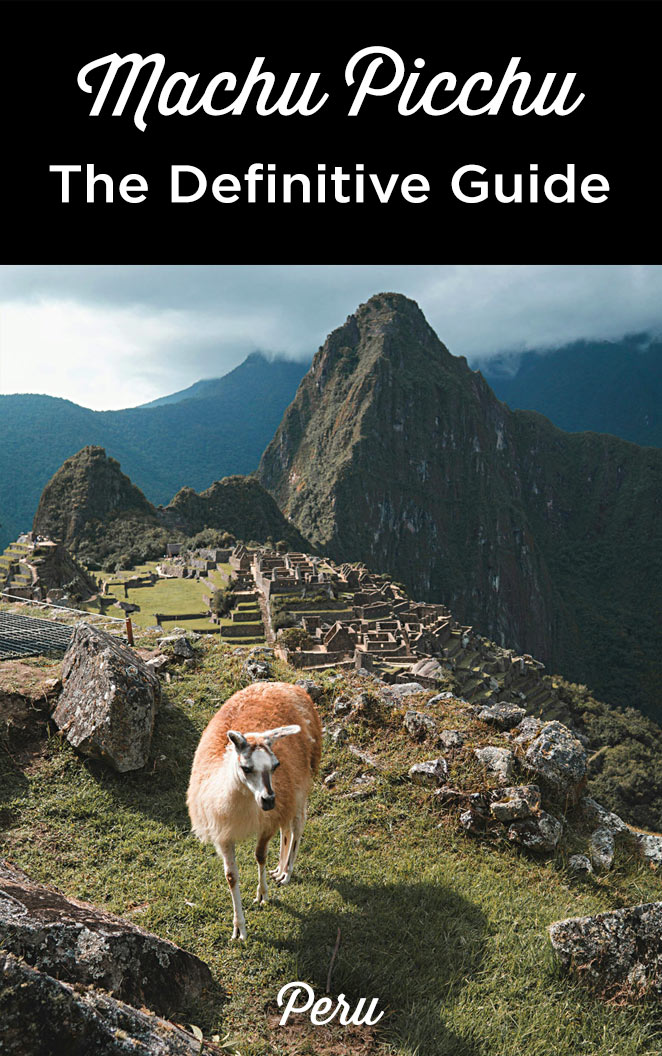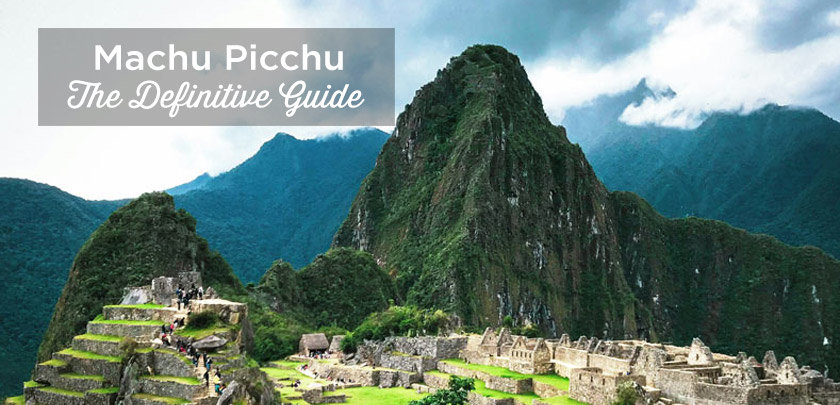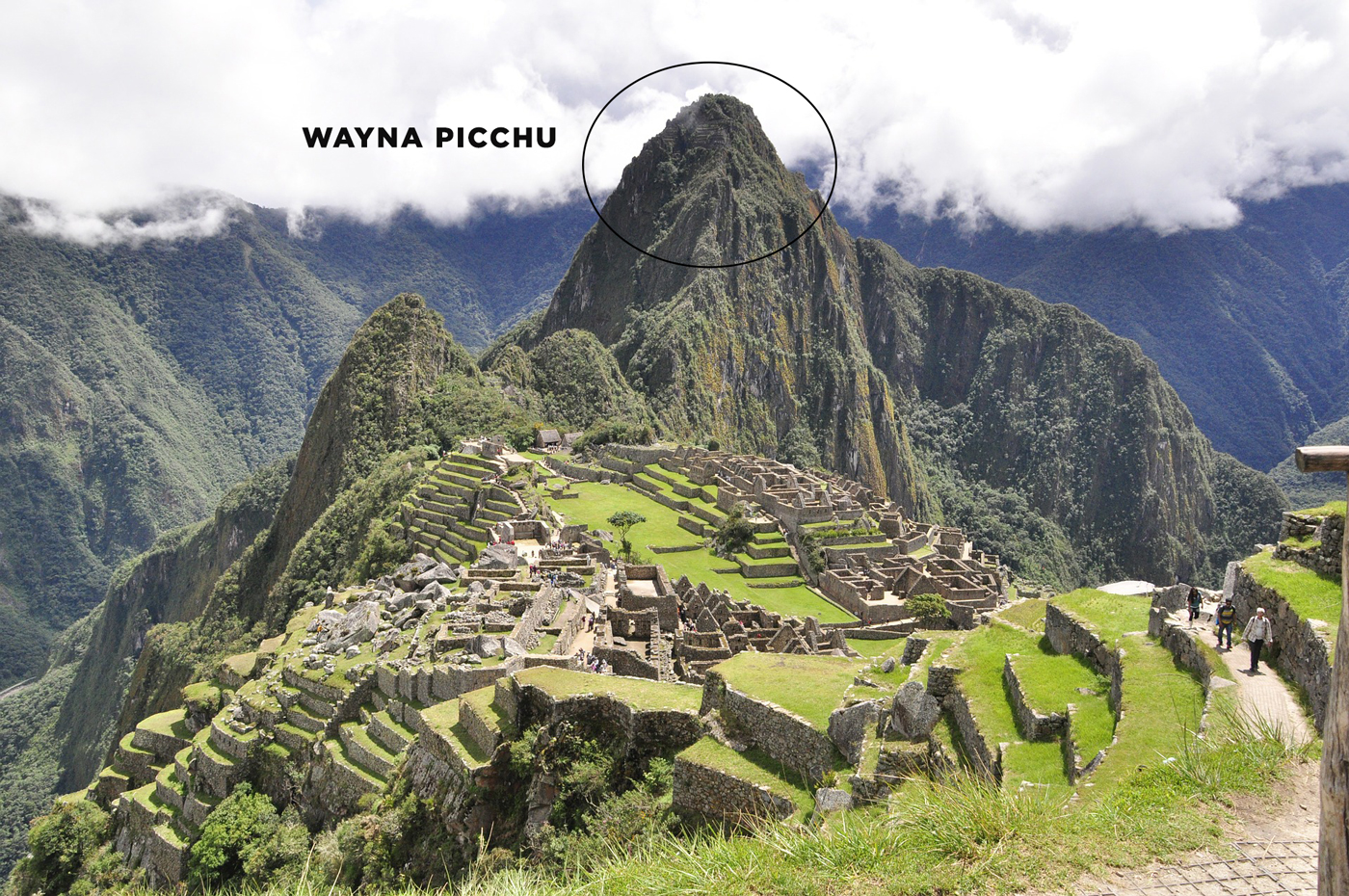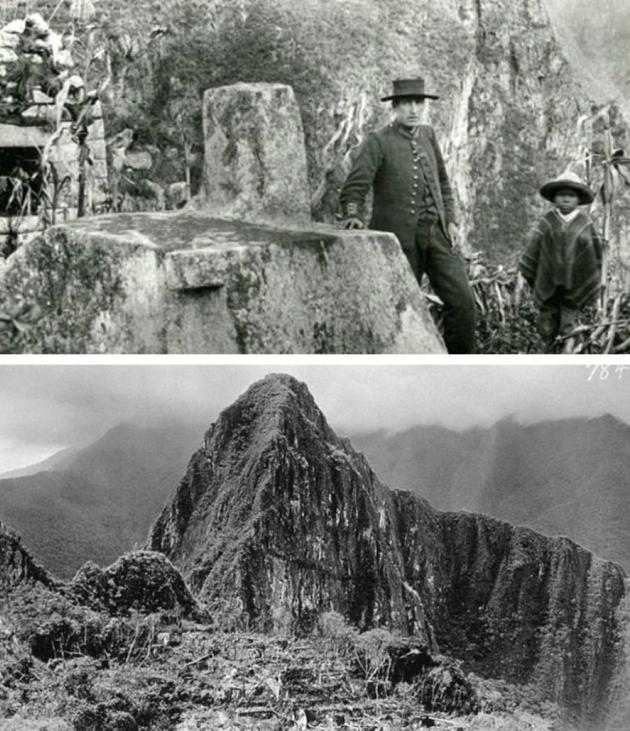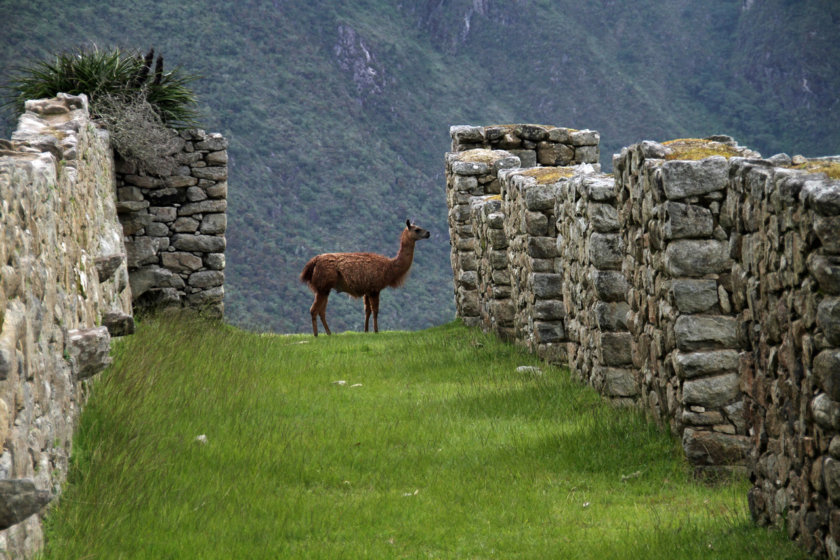Visiting Machu Picchu in 2025: My Best Tips!
A must-visit on any trip to Peru, Machu Picchu is the most iconic symbol of the Inca civilization. Its name means “Old Mountain” in Quechua.
Recognized as one of the New 7 Wonders of the World, it’s also Peru’s top tourist attraction and one of the most important archaeological sites in South America!
To help you plan your visit, I’ve put together this Complete Machu Picchu Guide for 2025, packed with up-to-date info and my best tips.
I’ll walk you through how to choose and buy your tickets, navigate the new routes and circuits, get to Machu Picchu, what to see and do once you’re there… and much more!
So, how do you visit Machu Picchu? Where should you stay?
Let’s dive in!
Sommaire
- Visiting Machu Picchu in 2025: My Best Tips!
- Machu Picchu Entrance Tickets: Everything You Need to Know
- The 10 Routes of Machu Picchu: Which One to Choose?
- Machu Picchu Tickets: FAQ
- Should You Purchase Machu Picchu Tickets in Advance?
- Is it possible to buy a ticket at the entrance to Machu Picchu?
- I can’t pay with my card. What should I do?
- Purchasing a Machu Picchu Ticket with Someone Else’s Card
- What to Do if I Entered Incorrect Information?
- How to Make Changes to My Machu Picchu Ticket?
- How to Get to Machu Picchu?
- How to Visit Machu Picchu in One Day
- How to Visit Machu Picchu in 2 Days
- Guided Tour of Machu Picchu
- Accommodation at Machu Picchu – the Best Hotels
- Other Frequently Asked Questions About Machu Picchu
- Where is the classic photo of Machu Picchu taken from?
- Are there toilets at Machu Picchu?
- Are there lockers at Machu Picchu?
- Is there a restaurant at Machu Picchu?
- Can I re-enter if I exit?
- Is Machu Picchu closed in February?
- What is the altitude of Machu Picchu?
- Will I feel altitude sickness at Machu Picchu?
- How to Get the Machu Picchu Stamp on Your Passport?
- When to Visit Machu Picchu? (Weather)
- The History of Machu Picchu
- What to See at Machu Picchu?
- What to Bring to Machu Picchu?
- What Not to Do or Bring to Machu Picchu (Prohibitions)
- Book Your Flight at the Best Price
- Rent a Car in Peru
- Traveling to Peru? These articles will help you!
Machu Picchu Entrance Tickets: Everything You Need to Know
Where and How to Buy Your Machu Picchu Tickets
You can buy tickets online or on-site, but not all options are equally reliable. Here’s what you need to know:
1. Buy Machu Picchu Tickets on GetYourGuide (The Easiest Way)
Purchasing through the official Machu Picchu website can be frustrating. The site frequently has technical issues, especially during the final payment step.
Some travelers have even reported not receiving their ticket confirmation!
To avoid these headaches, a more reliable and faster alternative is booking through GetYourGuide. While slightly more expensive, it guarantees an easy, secure, and hassle-free ticket purchase.
There are three types of tickets available—simply click the green button below to book the one you need:
Machu Picchu + Huayna Picchu Ticket
Machu Picchu + Machu Picchu Mountain Ticket
Machu Picchu Ticket Only
2. Buy Machu Picchu Tickets on the Official Website (Step by Step)
Here’s how to buy your Machu Picchu ticket on the website, step by step:
1. Visit tuboleto.cultura.pe and click on “Machu Picchu”
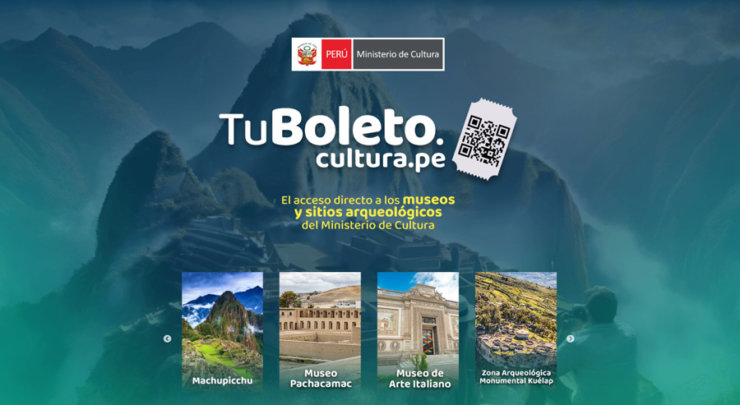
2. Select your tickets
- Select a rate (general rate) and a route from the list
- Choose a date and a time (a number will indicate the remaining seats. If it shows AGOTADO in red, the tickets are sold out)
- Choose the number of tickets
- Check the small box on the right (your consent for personal data to be transmitted)
- Click the red button “comprar entradas” (buy tickets)
If you’re not sure which one to choose, check out the Machu Picchu Routes section where I give you all the details.
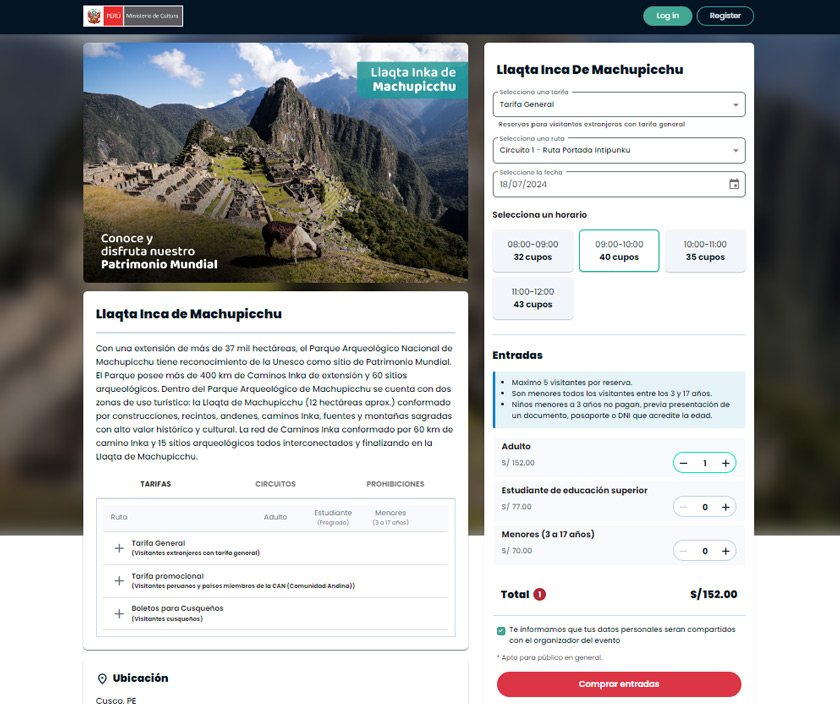
3. A pop-up window will appear prompting you to log in to your Joinnus account (you’ll need to create an account if you haven’t already).
4. The purchase page will appear. Enter the visitor’s details. Complete the information and click on “Continuar” to make the payment.
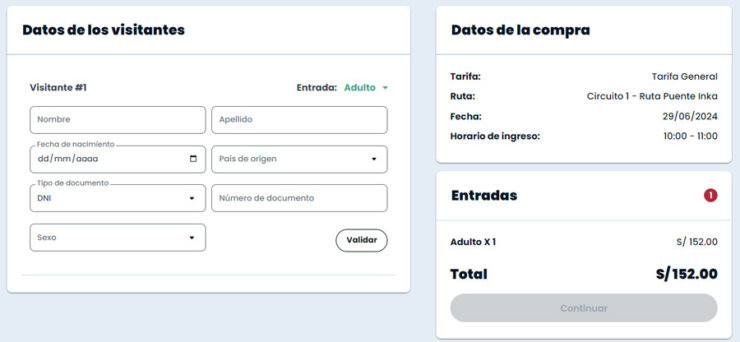
Same here! I’ve tested the site several times and encountered numerous bugs.
It’s not the first time (I’ve experienced all the previous versions over 10 years), but I thought that with this new website, buying tickets online would finally be easy in 2024.
Give it a try, and if it doesn’t work, the easiest solution is to buy the tickets from GetYourGuide (click on the ticket name to book):
- The Machu Picchu (Circuit 2 – the most complete route to see several highlights)
- The Machu Picchu + Huayna Picchu (Highly recommended for a first visit – must be booked several months in advance!)
- The Machu Picchu + Machu Picchu Mountain (The best alternative if Huayna Picchu is fully booked)
3. Buying Machu Picchu tickets in Cusco
It is possible to buy Machu Picchu tickets once you’re there, but it’s not the option I recommend because you must book Huayna Picchu several months in advance and Machu Picchu Mountain several weeks in advance.
Even for the “basic” Machu Picchu ticket during the high season, it’s quite risky because tickets sell out quickly, especially those for the morning.
But if you prefer to wait until the last minute because you don’t have the exact date of your visit to Machu Picchu yet, here’s where to go in Cusco:
- Palacio Inka de Kusicancha, Calle Maruri 340, Mon-Sat 7 a.m.-7:30 p.m.
- Casa Garcilaso, opposite Plaza Regocijo, Mon-Sat 7 a.m.-7:30 p.m.
Personally, I would be afraid of ending up without a ticket on the day of my visit!
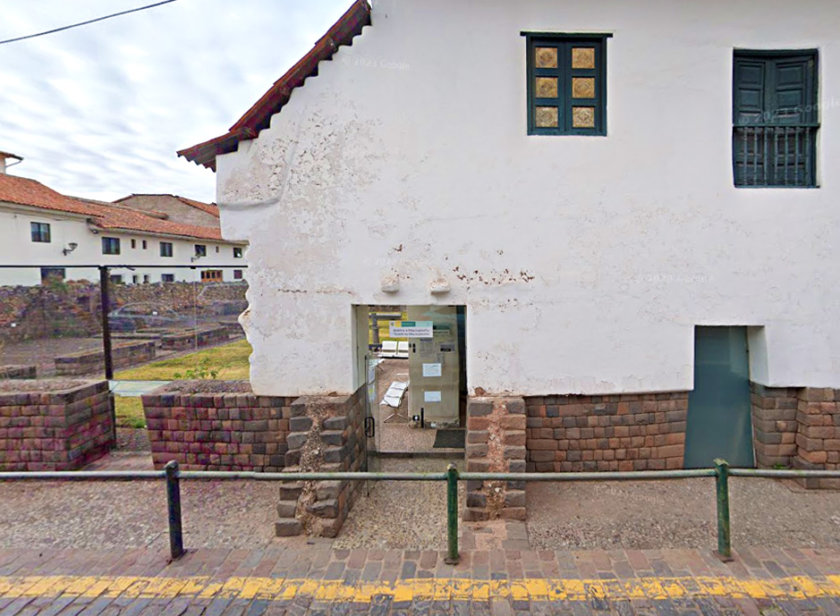
Differences between Huayna Picchu and Machu Picchu Mountain
To fully understand the differences between the two mountains (difficulty, height, best photos, etc.), I invite you to read my Comparison of Huayna Picchu and Machu Picchu Mountain.
Here’s a brief overview:
1. Huayna Picchu (Wayna Picchu)
The Huayna Picchu (2700m) is the mountain you see in all the classic photos of the site.
From the summit, you get an impressive bird’s-eye view of the Machu Picchu site.
- Difficulty: the climb is quite demanding, steep, with stairs, as well as narrow and rugged paths, so you need to be fit to climb it. Absolutely avoid it if you have a fear of heights.
- The round trip takes about 2-2.5 hours
- Wayna Picchu is VERY popular, so you must book several months in advance!
2. Machu Picchu Mountain
The Machu Picchu Mountain (3082m) shouldn’t be confused with the Machu Picchu site. It’s the mountain opposite the Wayna Picchu.
It’s higher than the latter and offers a different viewpoint over the site and surroundings.
- Difficulty: the journey is longer but the ascent is less steep and demanding than the Wayna Picchu. It’s a better option if you’re afraid of heights
- The round trip takes about 3 hours
- The Machu Picchu Mountain is less crowded than Wayna Picchu, but you still need to book your spot several weeks in advance!
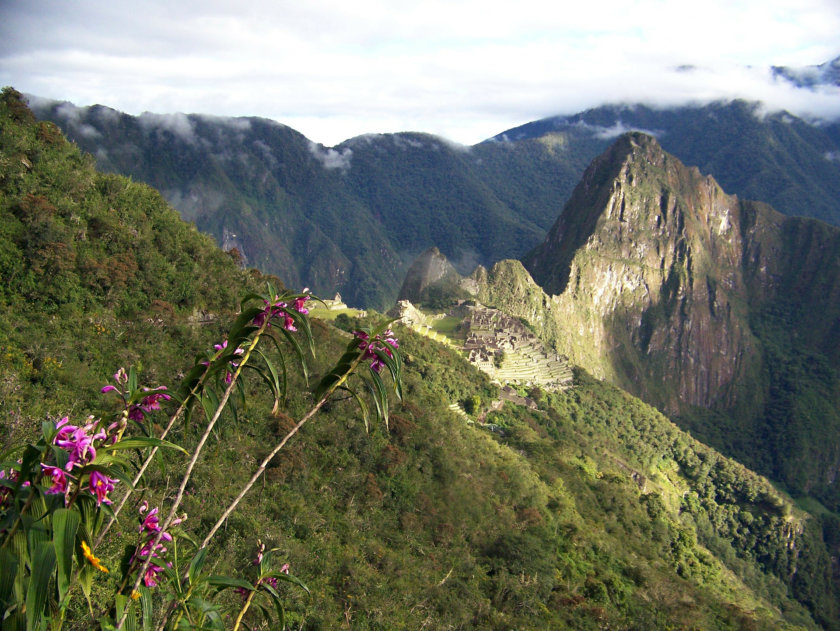
How Much Do Machu Picchu Tickets Cost?
The price of Machu Picchu tickets depends on the route you choose.
Below are the official entrance fees for Machu Picchu:
| Ticket | Foreign price (adult) | Foreign price (under 18) | National price (adult) | National price (under 18) |
|---|---|---|---|---|
| Circuit 1: Terraza Superior, Intipunku or Puente Inka | 152 soles | 70 soles | 64 soles | 32 soles |
| Circuit 1: Montaña Machu Picchu | 200 soles | -- | 112 soles | -- |
| Circuit 2: Clásica or Terraza Inferior | 152 soles | 70 soles | 64 soles | 32 soles |
| Circuit 3: Waynapicchu | 200 soles | -- | 112 soles | -- |
| Circuit 3: Gran Caverna | 200 soles | -- | 112 soles | -- |
| Circuit 3: Ruta Realeza diseñada | 152 soles | 70 soles | 64 soles | 32 soles |
| Circuit 3: Huchuy Picchu | 152 soles | -- | 64 soles | -- |
Machu Picchu Ticket Schedule
Your Machu Picchu ticket has a specific entry time. With the new regulations, schedules are strictly enforced, so it’s essential to arrive on time.
Below are the official entry times for Machu Picchu tickets:
Circuit 1
Ruta Machu Picchu Montaña (Machu Picchu Mountain)
- 1st tour: entry to Machu Picchu from 6 am + entry to Machu Picchu Mountain from 7 am to 8 am
- 2nd tour: entry to Machu Picchu from 8 am + entry to Machu Picchu Mountain from 9 am to 10 am
Ruta Terraza Superior: 6 am, 7 am, 8 am, 9 am, 10 am, 11 am, 12 pm, 1 pm, 2 pm, 3 pm
Ruta Portada Intipunku (high season only): 8 am, 9 am, 10 am, 11 am
Ruta Puente Inca (high season only): 8 am, 9 am, 10 am, 11 am
Circuit 2
All 2 routes: 6 am, 7 am, 8 am, 9 am, 10 am, 11 am, 12 pm, 1 pm, 2 pm, 3 pm
Circuit 3
Ruta Realeza Disenada: 6 am, 7 am, 8 am, 9 am, 10 am, 11 am, 12 pm, 1 pm, 2 pm, 3 pm
Ruta Montaña Huayna Picchu (Wayna Picchu)
- 1st tour: entry to Machu Picchu from 6 am + entry to Huayna Picchu from 7 am to 8 am
- 2nd tour: entry to Machu Picchu from 7 am + entry to Huayna Picchu from 8 am to 9 am
Ruta La Gran Caverna: 7 am, 9 am
Ruta Montaña Huchuy Picchu: 10 am, 12 pm (high season); 7 am, 9 am (low season)
Beyond that, you may be denied entry.
The 10 Routes of Machu Picchu: Which One to Choose?
When purchasing Machu Picchu tickets on the official website, you now have to choose 1 of the 10 available routes, with 4 of them only open during high season (June 1 – October 15 and December 30-31).
Which Is the Best Route in Machu Picchu?
Each route has its highlights (see the detailed descriptions in the next section).
The routes of circuits 1 and 2 offer the classic postcard view of Machu Picchu from the Guardian’s House.
In general, circuit 1 offers more stunning panoramic views, while circuit 2 provides a more complete tour of Machu Picchu.
For a classic Machu Picchu visit, I recommend Circuit 2 – Ruta Clásica Diseñada, which covers the most important highlights of Machu Picchu – Book your tickets here!
If you want to visit Huayna Picchu, choose Circuit 3 – Ruta Montaña Waynapicchu – Book your Wayna Picchu tickets here!
To visit Machu Picchu Mountain, select Circuit 1 – Ruta Montaña Machupicchu – Book your Machu Picchu Mountain tickets here!
For senior visitors, I suggest Circuit 3 – Ruta Realeza Diseñada, which focuses on the lower section of Machu Picchu, including the agricultural terraces and important Inca structures like the Temple of the Condor and Temple of the Sun. This route is less physically demanding.
- Circuit 1 – Ruta Montaña Machupicchu
- Circuit 1 – Ruta Puente Inka
- Circuit 3 – Ruta Montaña Waynapicchu
- Circuit 3 – Ruta Gran Caverna
- Circuit 3 – Ruta Huchuypicchu
Machu Picchu Itineraries and Routes Detailed
To help you choose the right ticket, here are the details of the 3 circuits at Machu Picchu, divided into 10 routes or itineraries:
1. Circuit 1 – Ruta Montaña Machupicchu
2. Circuit 1 – Ruta Terraza Superior
3. Circuit 1 – Ruta Portada Intipunku (only in high season)
4. Circuit 1 – Ruta Puente Inka (only in high season)
5. Circuit 2 – Ruta clásica diseñada
6. Circuit 2 – Ruta Terraza Inferior
7. Circuit 3 – Ruta Montaña Waynapicchu
8. Circuit 3 – Ruta Realeza diseñada
9. Circuit 3 – Ruta Gran Caverna (only in high season)
10. Circuit 3 – Ruta Huchuypicchu (only in high season)
1. Circuit 1 – Ruta Montaña Machupicchu
- Duration: 1h + 4h (Machu Picchu mountain). Maximum time of 7h allowed on site.
- This route grants access to: the Guardian’s House (classic view of Machu Picchu) and the Machu Picchu mountain
- 18 years and older only
All Circuit 1 tickets allow you to walk to the Guardian’s House to get the classic view of Machu Picchu (just like in the photos!), as well as a viewpoint over various structures such as the Temple of the Sun, the Sacred Plaza, and the Temple of the Three Windows, the Intihuatana.
- Note that this is only a high viewpoint, you cannot access these structures with this ticket
Additionally, with this specific itinerary, you can take the trail up to Machu Picchu mountain (round trip 3-4h) which offers a stunning 360° panoramic view from its summit. Then, you will return to the entrance via the same path.
Therefore, this is the ticket to choose for the hike on Machu Picchu Mountain.
If you want a ticket that includes access to the mountain, remember that it is necessary to book several weeks in advance:
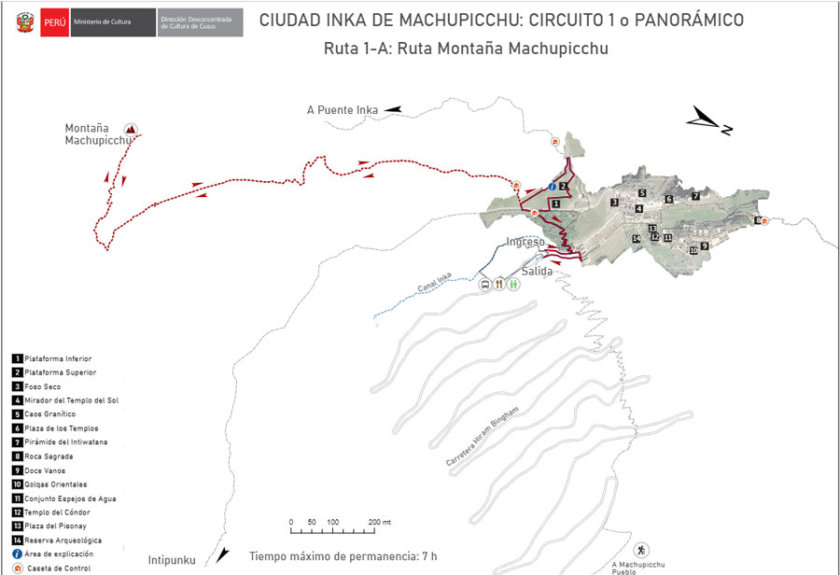
2. Circuit 1 – Ruta Terraza Superior
- Duration: 3h
- This route provides access to the Guardian’s House (classic view of Machu Picchu)
This Circuit 1 ticket is the basic ticket that allows you to access the Guardian’s House, offering a picturesque view over the ruins and several important structures (Temple of the Three Windows, Temple of the Sun, etc.), but without any additional hike.
Once again, just like with the previous ticket, you cannot access the area where these structures are situated. It’s simply a distant view.
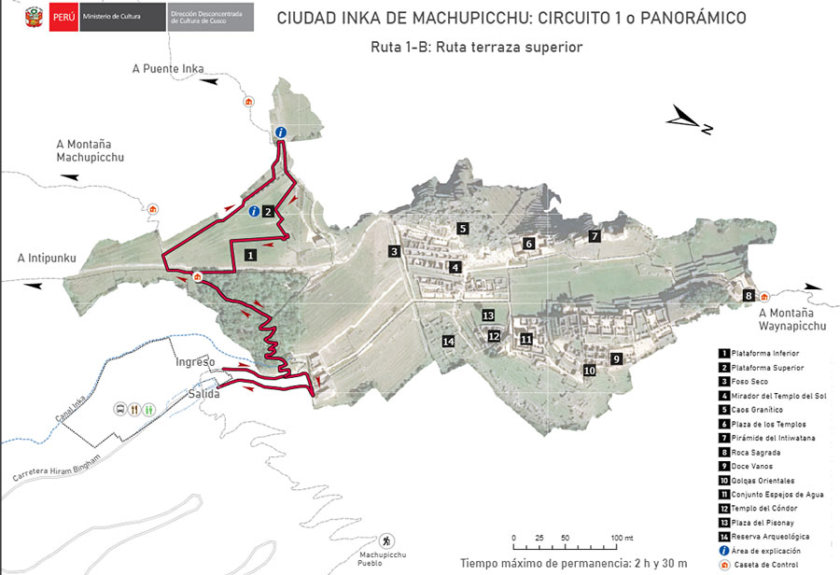
3. Circuit 1 – Ruta Portada Intipunku (only in high season)
- Duration: 4h
- This route provides access to: the Guardian’s House (classic view of Machu Picchu) and Inti Punku (the Sun Gate)
- Available only from June 1st to October 15th, and December 30-31
Circuit 1 ticket grants access to the Casa del Guardián, offering the classic viewpoint of the Machu Picchu site.
You will then have the opportunity to walk a section of the Inca Trail, climbing up to Inti Punku, the original entrance to Machu Picchu. During the Inca era, this area served as a checkpoint for those entering the citadel.
From the Sun Gate (at 3,745m altitude), you’ll enjoy breathtaking panoramic views of the surrounding landscapes.
*Today, the only visitors who can enter Machu Picchu through this gate are those hiking the Inca Trail!
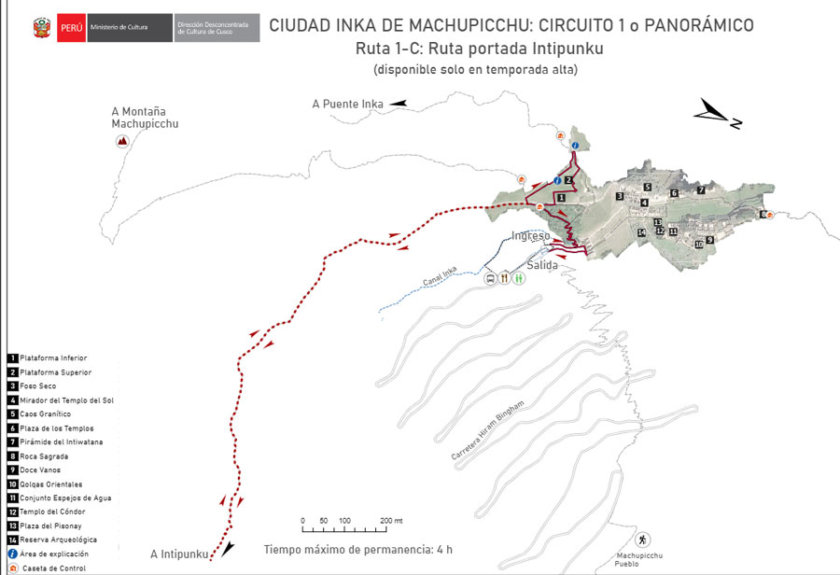
4. Circuit 1 – Ruta Puente Inka (only in high season)
- Duration: 1 hour (route) + 1 hour (Puente Inca). Maximum allocated 3 hours
- This itinerary grants access to: the Guardian’s House (classic view of Machu Picchu) and the Inca Bridge
- Accessible only for ages 18 and over, from June 1 to October 15, and December 30-31
This Route 1 itinerary gives you access to the Casa del Guardian, considered the best lookout of Machu Picchu, offering a breathtaking view of the citadel and its surroundings.
You can then walk to the Inca Bridge – a 1-hour round trip from the Guardian’s House.
The Machu Picchu Inca bridge is a wooden structure resting on a narrow stone path on the edge of a cliff. In case of an invasion, it could easily be removed to block access to the citadel!
For safety reasons, you can’t cross the bridge, but you can approach it from a safe distance. The path is easy, not physically demanding, but be cautious, especially if you’re afraid of heights.
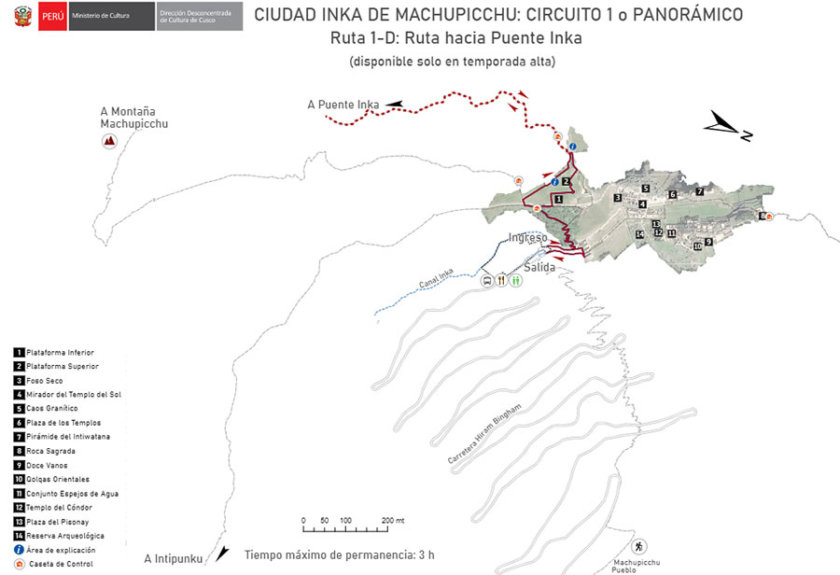
5. Route 2 – Classic Designed Route
- Duration: 2 hours and 30 minutes
- This itinerary grants access to: the platform under the Guardian’s House (same classic view), agricultural, urban, and religious sectors
This Route 2 itinerary allows you to take the classic photo of Machu Picchu, from a platform located below the Guardian’s House.
Then, you can access the agricultural, urban, and religious sectors of the citadel: The Temple of the Sun, the Temple of the Three Windows, the Main Temple, the terraces, and more.
This is a very comprehensive Machu Picchu route: ideal for a first visit, if you are not keen on climbing Huayna Picchu.
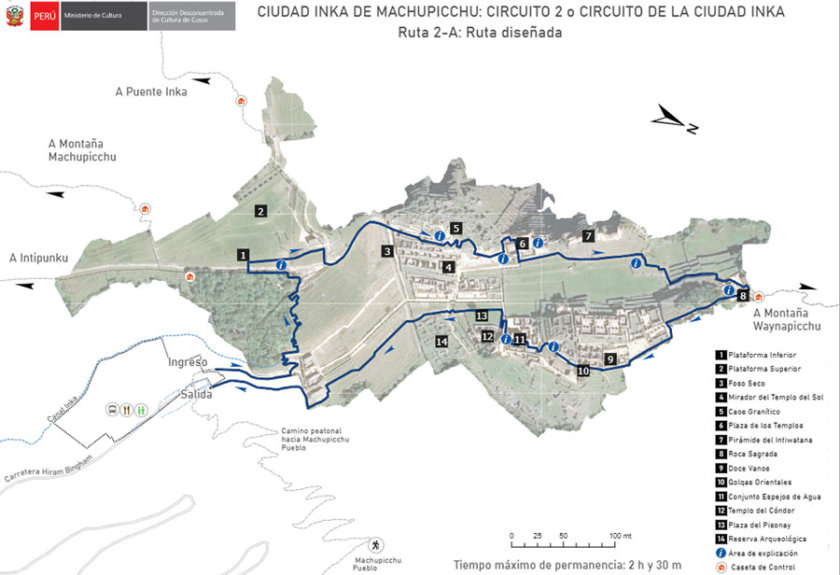
6. Route 2 – Lower Terrace Route
- Duration: 2 hours and 30 minutes
- This itinerary grants access to: the classic view of Machu Picchu (from a lower terrace), agricultural, urban and religious sectors
This Route 2 itinerary is very similar to the previous one. The main difference is that instead of having access to the platform under the Guardian’s House, you arrive at a lower terrace, but it offers the same view.
It also includes access to the urban and religious areas, as well as the agricultural terraces, making it a very comprehensive route too.
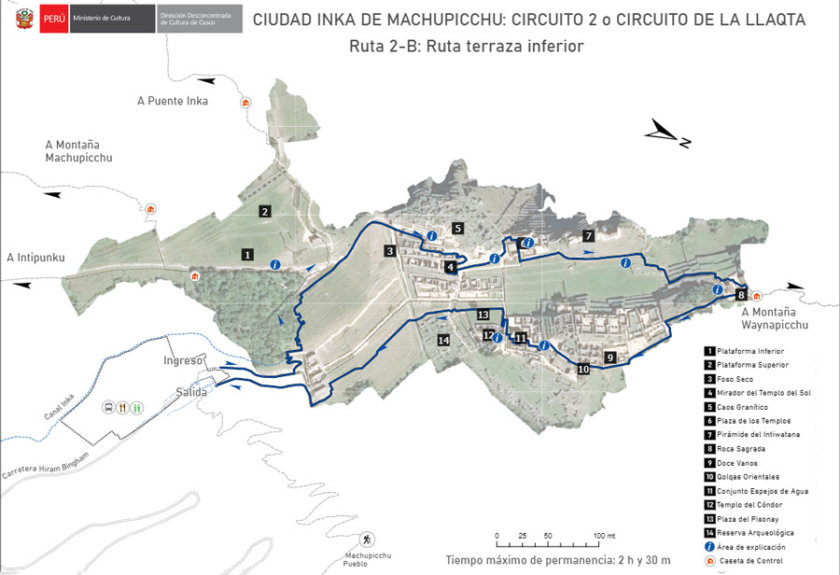
7. Route 3 – Huayna Picchu Mountain Route
- Duration: 1 hour (route) + 3 hours (Huayna Picchu). Maximum allocated 6 hours
- This itinerary grants access to the elite area and Huayna Picchu
- Only for ages 18 and over
All Route 3 tickets include the Inca elite sectors, located in the lower part of Machu Picchu: Temple of the Condor, the sacred rock, agricultural terraces, the Temple of the Sun, and more.
In the agricultural area, you get a similar view to the famous classic photo of Machu Picchu.
This Route 3 itinerary also grants access to Huayna Picchu!
It’s a steep climb, so you need to be fairly fit and especially not have a fear of heights. But the effort is worth it because it’s a unique experience and the view from the summit is breathtaking!
Huayna Picchu is in high demand and tickets are limited. I strongly suggest you get them several months in advance:
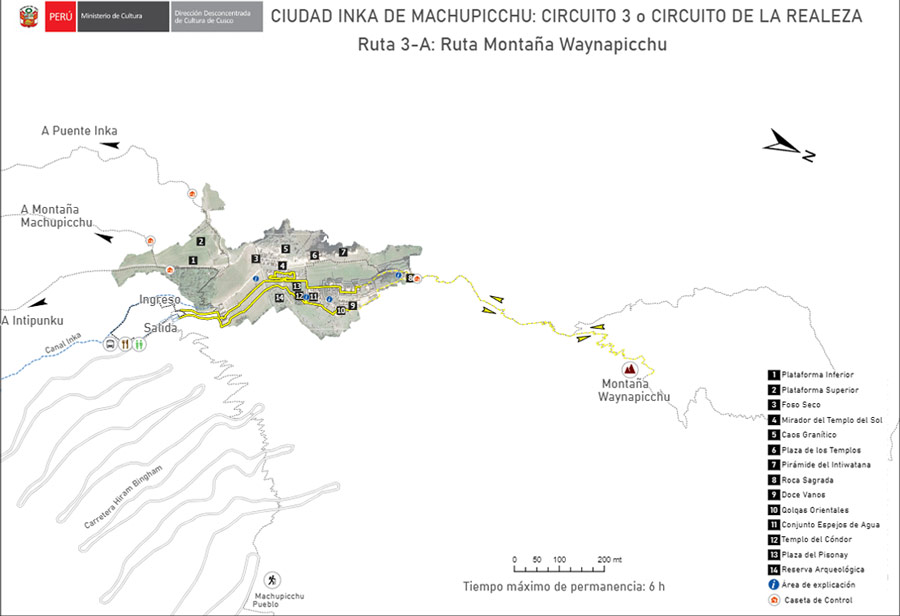
8. Route 3 – Designed Royal Route
- Duration: 3h30
- This itinerary allows access to the elite zone
It’s the basic route for circuit 3, so you’ll get to see the Inca nobility sector (Temple of the Condor, Temple of the Sun, etc.), without any additional hiking.
You’ll also have a view similar to the traditional photo of Machu Picchu.
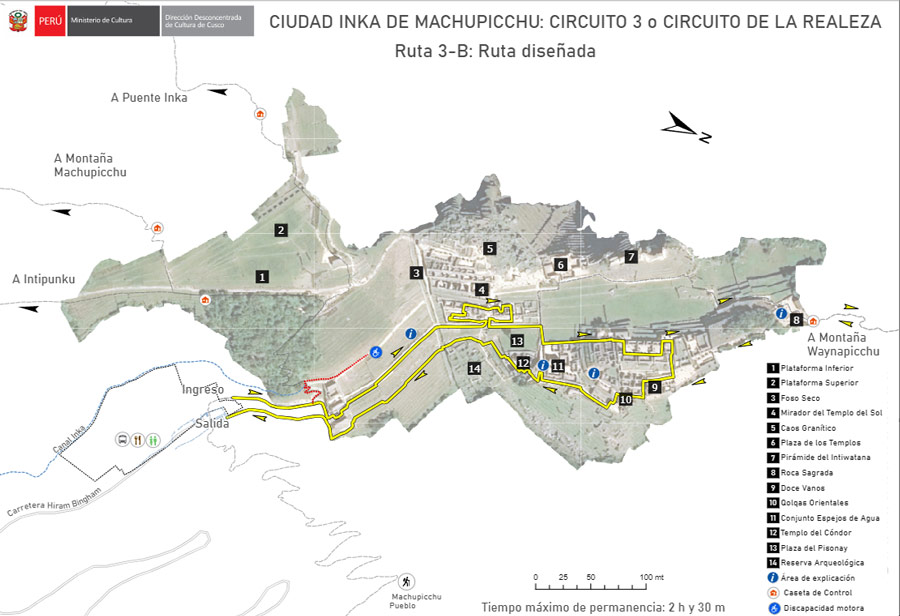
9. Circuit 3 – Ruta Gran Caverna (only during high season)
- Duration: 1h (circuit) + 4h (Gran Caverna). Maximum allotted time 7h
- This itinerary allows access to the elite zone and the Temple of the Moon
- Only for ages 18 and over, from June 1st to October 15th, and December 30-31
This circuit 3 ticket grants access to the elite zone, as well as to the Great Cavern.
Also known as the Temple of the Moon, it’s a natural cave located in the Huayna Picchu mountain.
It features perfectly interlocked stone blocks. The exact purpose remains unknown, but it’s believed that the throne found inside was used for sacrifices.
To reach it, you must walk for about 2 hours along the back part of Huayna Picchu. It’s a less touristy area of Machu Picchu that offers a good dose of adventure!
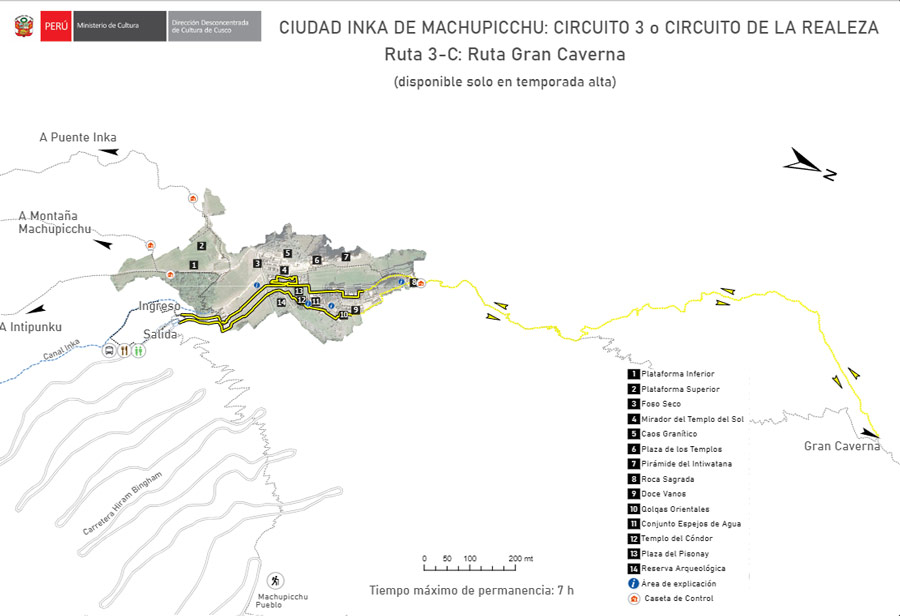
10. Circuit 3 – Ruta Huchuypicchu (only during high season)
- Duration: 1h (circuit) + 1h (Huchuy Picchu)
- This itinerary allows access to the elite zone and Huchuy Picchu
- Only for ages 18 and over, from June 1st to October 15th, and December 30-31
This circuit 3 ticket provides entry to the lower part of Machu Picchu where the elite buildings are located (Temple of the Sun, House of the Inca, etc.), in addition to access to the Huchuy Picchu mountain.
You enter via the same gate as Huayna Picchu, then the path forks.
It’s a short 30-minute climb to a viewpoint offering views as stunning as those from Huayna Picchu but requires less physical effort.
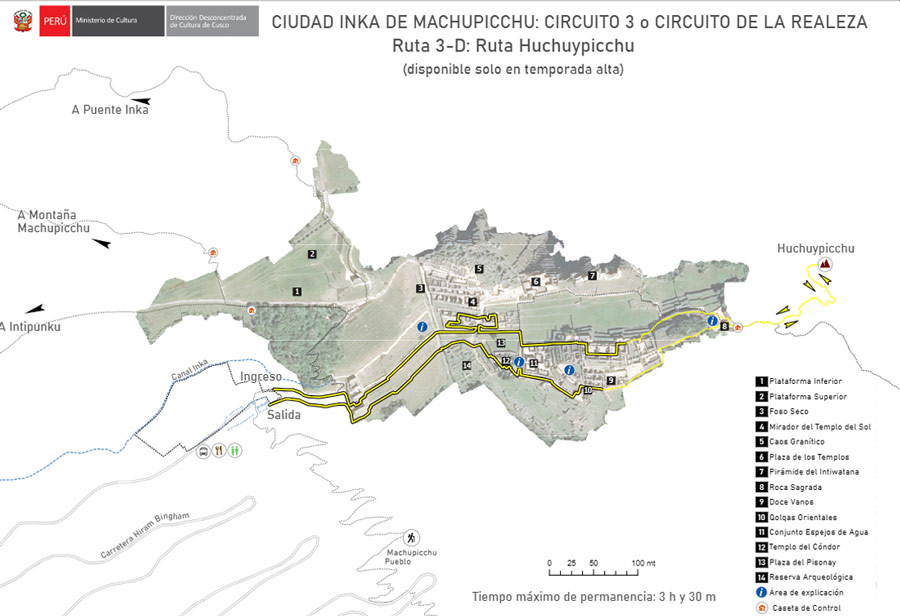
Machu Picchu Tickets: FAQ
Should You Purchase Machu Picchu Tickets in Advance?
Absolutely!
Machu Picchu is the most visited attraction in Peru and one of the most famous in Latin America.
Moreover, each year Peru welcomes an increasing number of tourists. If you wait until you’re in Cusco (or worse, Aguas Calientes!) to get your ticket, there’s a chance they could be sold out, especially during high season (June to October).
As for the Machu Picchu + Huayna Picchu ticket, you must book several months in advance as it’s very popular and availability is much more limited.
For Machu Picchu + Machu Picchu Mountain, it’s also necessary to book ahead. Generally, you should plan to book about **1.5 to 2 months in advance** to secure spots during high season.
Is it possible to buy a ticket at the entrance to Machu Picchu?
No, it’s impossible to buy them directly at Machu Picchu.
You must purchase them in advance online, or in person at Cusco or Aguas Calientes.
I can’t pay with my card. What should I do?
The Machu Picchu website sometimes experiences issues with foreign credit cards. The best thing to do is close everything and try again, entering the reservation code. You’re allowed a maximum of 5 attempts.
If it still does not work, then your other options are to purchase the Machu Picchu ticket elsewhere online on Getyourguide or through an agency.
Purchasing a Machu Picchu Ticket with Someone Else’s Card
It is entirely possible to buy a Machu Picchu ticket for someone else.
Normally, no one asks for it once on site, but as a precaution, I would advise having a photocopy of the credit card and the cardholder’s passport.
What to Do if I Entered Incorrect Information?
There are some details that aren’t too critical: country of origin, gender, and age.
But the following must be accurate: first name, last name, and passport number. And of course, the visitation date and time!
It’s very important to check everything before arriving at the site, as there will be no refunds (or possibility to change the date) if you are denied entry to Machu Picchu.
How to Make Changes to My Machu Picchu Ticket?
You are better off asking them directly: callcenter@culturacusco.gob.pe, phone 51 84 58 2030, or by visiting their office Casa Garcilaso in Cusco.
Change fees are as follows:
- 30% penalty if the request is made 24 hours before the visit
- 25% if requested 48 hours before the visit
- 10% if requested 72 hours or more before the visit
How to Get to Machu Picchu?
To get to Machu Picchu, you must go through Aguas Calientes, also called Machu Picchu Pueblo.
- Discover my Complete Guide to Aguas Calientes to learn about all the activities you can do there!
Step 1. Getting to Aguas Calientes
Here’s how to get to Aguas Calientes from Lima, Cusco and Ollantaytambo (Sacred Valley of the Incas).
From Lima to Machu Picchu
To get from Lima to Machu Picchu, you must first travel to Cusco: by bus or plane.
Lima to Cusco by Bus:
- Taking a bus from Lima to Cusco takes about 22 hours
- It’s the least expensive option
- Choosing a reputable and reliable company such as Cruz del Sur, Moviltours, Tepsa, Ormeño, and Civa is crucial
- The route is quite windy due to the mountains, so nausea is possible
Lima to Cusco by Plane:
- The flight from Lima to Cusco lasts 1 hour and 15 minutes. Flights depart every 30 minutes from Jorge Chavez Airport
- Several airlines offer this route and prices vary greatly.
I recommend using our flight comparison tool to find the best price for your Lima to Cusco tickets.
Be careful with altitude sickness: take it easy upon arriving, have a little coca tea, and take a nap if you can!
From Cusco or Ollantaytambo to Machu Picchu
You can get there by local transportation (+walk), hiking, or train.
1. Local Transport + Walk
This is the least touristy, the least expensive, and the longest option.
The journey includes a bus and walk from Cusco to Aguas Calientes via Hidroelectrica:
Option 1 (longer)
- Cusco to Santa Maria: 5 hours in colectivo from Santiago terminal (15 soles or 30 soles by bus)
- Santa Maria to Santa Teresa: 2 hours in colectivo (6 soles or 10 soles for a shared taxi)
- Taxi from Santa Teresa to Hidroelectrica: 20 minutes (6 soles)
- Hidroelectrica to Aguas Calientes (10 km): by train 40 minutes (31 USD) or on foot (3 hours) following the railway tracks
- The total journey is long (about 9-10 hours) from Cusco, so if night falls, spend the night in Santa Teresa to continue your journey safely the next day.
Option 2 (more direct and faster, a better option in my opinion!)
- Cusco – Hidroelectrica (7 hours): 30 USD in colectivo for a round-trip. The return journey is around 2 PM (time to be confirmed with the company).
- Hidroelectrica – Aguas Calientes (10 km): by Peru Rail train 40 minutes (2 departures: 7:54 AM, 2:50 PM) or on foot 2.5-3 hours
2. Go on a Trek
There are several treks to Machu Picchu, some more well-known than others, but all are worth exploring!
Inca Trail
The Inca Trail (4 days with 3 nights camping) is the only trek that allows you to arrive directly at Machu Picchu!
Besides being the most famous trek, it is subject to very limited quotas: it’s very important to book several months in advance to secure a spot!
- Important to know: it is closed for the entire month of February each year.
- For everything you need to know about the Inca Trail here is My complete article on the Inca Trail!
To book your Inca Trail right now, click the button below:
You can easily book it here:
Salkantay Trek
After the Inca Trail, the Salkantay Trek is the most well-known. It has been named by National Geographic as one of the best treks in the world, and it truly deserves it!
- To know all the details about the trek here is my detailed article on the Salkantay Trek
You can book the 5-day Salkantay Trek with a reliable agency here:
Lares Trek
The Lares Trek (4 days and 3 nights) is a lesser-known hike, hence less crowded. The experience focuses more on meeting local communities and enjoying very picturesque landscapes.
It’s a great option if you prefer less touristy activities!
- Discover: My article on the Lares Trek
You can book the Lares Trek here with hotel pickup, all entrance fees, transportation to Lares, round-trip train, meals, guides, and porters, including 1 night in Aguas Calientes:
Inca Jungle Trail
This is a 4-day excursion for adrenaline junkies that combines hiking with several activities (downhill mountain biking, zip-lining, white-water rafting).
You can easily book the Inca Jungle Trail here:
Huchuy Qosqo Trek
Huchuy Qosqo is the most significant Inca site in the Sacred Valley after Ollantaytambo and Pisac.
It is only accessible on foot or by horse (there is no road), which makes it so special!
It’s an easy one-day hike (12km) including a visit to Huchuy Qosqo, followed by 1 night in Aguas Calientes before visiting Machu Picchu the next day.
- Important to know: other versions of this hike are available for up to 4 days, including camping.
- To read: The Huchuy Qosqo Trek
3. By Train
There are two train companies that operate the route: Peru Rail and Inca Rail.
1. Peru Rail
- There are 2 possible routes: Poroy (Cusco) to Aguas Calientes (3h) and Ollantaytambo to Aguas Calientes (1h30).
- From January 2nd to April 30th, the Poroy station is closed: the itinerary then starts with a bus ride from Cusco (Wanchaq station) to Ollantaytambo, followed by the train to Aguas Calientes.
- The price varies greatly depending on the category: Expedition, Vistadome, or the luxe Belmond Hiram Bingham (which includes transfer from the hotel in Cusco, meals and onboard entertainment, the Machu Picchu ticket with guided tour, and afternoon tea at the Belmond Sanctuary Lodge)
Where to buy your ticket with Peru Rail:
- Online on the Peru Rail website
- Cusco: Avenida Pachacutec (Wanchaq Station) Mon-Fri 7am-5pm, Sat-Sun 7am-12pm; Portal de Carnes, 214 (Plaza de Armas) Mon-Sun 7am-10pm; Plazoleta Regocijo, 202, Mon-Sun 7am-10pm
- Ollantaytambo: Avenida Ferrocarril (station) Mon-Sun 4am-9pm
- Aguas Calientes: (station) Mon-Sun 6am-9:30pm
2. Inca Rail
- Ollantaytambo–Aguas Calientes (between $50 and $60 USD one-way, duration 1h30).
- Train categories: Machu Picchu Train and Inca Train
Where to buy your ticket with Inca Rail:
- Online on the Inca Rail website
- Cusco: Portal de Panes, 105 (Plaza de Armas), Mon-Fri 9am-9pm, Sat 9am-7pm, Sun and holidays 9am-2pm
- Ollantaytambo: Avenida Ferrocarril (station), Mon-Sun 6am-8am, 9:45am-12:45pm and 2:45pm-5pm
- Aguas Calientes: (station) Mon-Sun 7am-9:30am, 12:30pm-2:30pm, 3:45pm-7:15pm
It’s important to arrive at the station 30 minutes before departure with 2 copies of the electronic tickets (e-tickets), one for check-in and the other to board the train… and don’t forget your passport!
You can get your train tickets to Aguas Calientes from Cusco or Ollantaytambo right here:
What is the maximum luggage weight allowed on the train?
As people usually spend a short amount of time in Aguas Calientes, Peru Rail and Inca Rail only allow one piece of carry-on luggage per person:
- Maximum 5 kg and 157 cm in length for Peru Rail
- Maximum 8 kg and 118 cm in length for Inca Rail
Where to Leave Luggage if I Can’t Take it on the Train?
There’s a luggage storage facility at the Ollantaytambo station (free with Peru Rail).
You can also leave them at your hotel in Cusco or Ollantaytambo. They’re used to it, everyone does it, and it’s usually free.
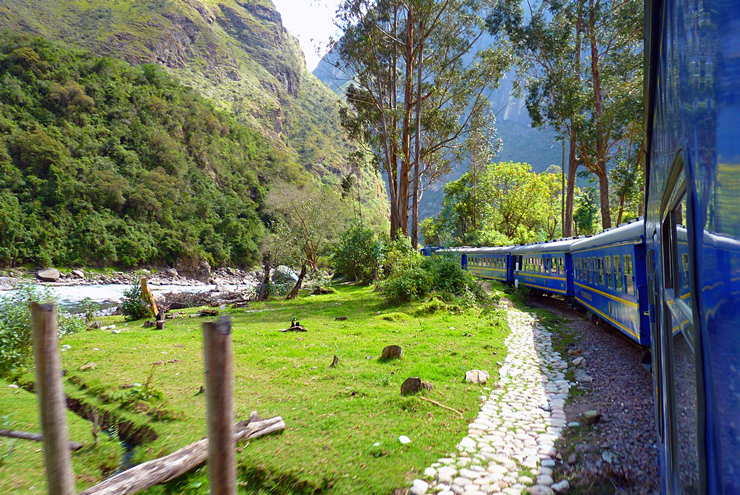
Step 2. Getting to Machu Picchu from Aguas Calientes
Once in Aguas Calientes, you can get to Machu Picchu by foot or by bus.
Walking Up to Machu Picchu
The ascent (1.5-2 hours) is quite steep and the path is dusty due to the buses passing by – you have to follow the same road for 2 km and then take the trail leading to Machu Picchu.
Once you arrive at Puente Ruinas, you will need to show your Machu Picchu ticket at the checkpoint to be allowed through. Further on, at the gates of Machu Picchu, you must present it again to gain access to the site.
If you’re in good shape, it’s a great way to save money while visiting Machu Picchu, but remember to calculate your time well to stick to the schedule of your entrance ticket!
Another option, to avoid arriving at Machu Picchu tired, would be to only get the ascent ticket and walk back down.
Taking the Bus to Machu Picchu
You need to take a bus operated by Consettur, leaving from Avenida Hermanos Ayar, close to the train station. Departures every 10 minutes.
- The bus ride takes 30 minutes. The view is spectacular, with the vast green valley and Vilcanota River in sight.
- The first bus to Machu Picchu leaves at 5:30 am and the last at 3:30 pm.
- The last bus back to Aguas Calientes is at 5:30 pm. If you miss it, you’ll face at least an hour’s walk, so plan your timing carefully!
Bus Prices to Machu Picchu
- Adults (International Travelers): one-way $12 USD, round-trip: $24 USD
- Children (International Travelers): one-way $7 USD, round-trip: $12 USD
How to Buy Bus Tickets to Machu Picchu:
You can buy them in Aguas Calientes, in Cusco, or easily online.
- Aguas Calientes: Avenida Hermanos Ayar S/N, from 5 AM to 9 PM. Personally, I would avoid buying tickets on the same day to prevent delays, as long queues are common, and Machu Picchu tickets have strict entry times!
- Cusco: Av. Infancia 433 (Wanchaq) from 8 AM to 1 PM and 3 PM to 6 PM; Avenida El Sol, 380 (Interbank) from 9 AM to 6 PM.
- Online (easiest option): You can purchase your round-trip bus ticket without waiting in line, here:
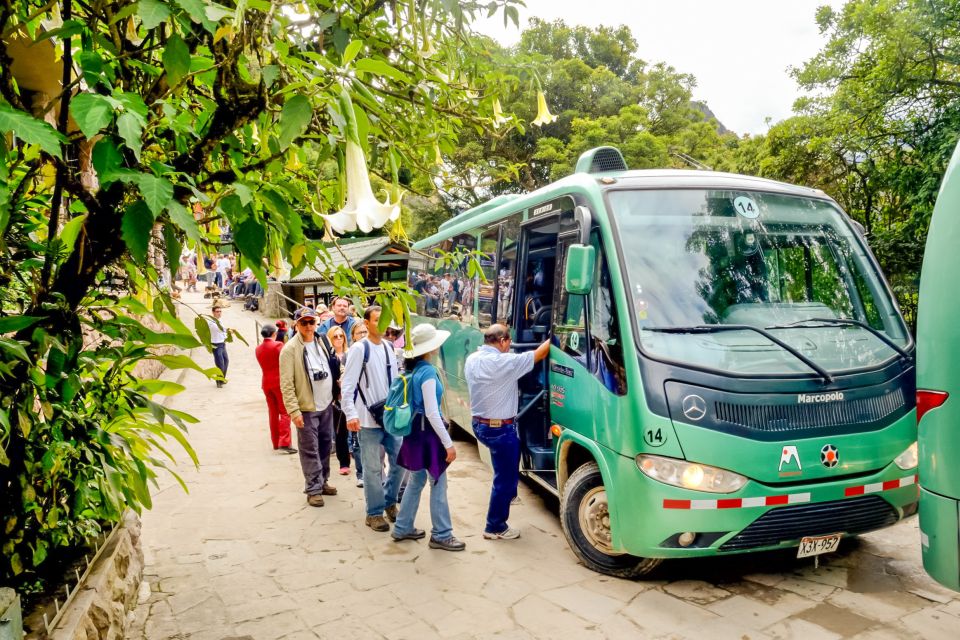
How to Visit Machu Picchu in One Day
If you only have one day to visit Machu Picchu, taking the train is your best option since local transportation takes too long.
Here’s how to do it from Cusco and Ollantaytambo (Sacred Valley of the Incas):
From Cusco
If you’re short on time, you’ll need to take the train to Aguas Calientes. The first train departs from Cusco at 6:40 AM and arrives at 9:54 AM.
Buy your tickets in advance, as the early morning train is very popular and sells out quickly!
From May to December, the departure is from Poroy station (20 min from Cusco). However, from January to April, trains only depart from Ollantaytambo.
Once in Aguas Calientes, take the bus up to Machu Picchu (25 min).
For the return: The last train to Cusco leaves Aguas Calientes at 5:20 PM. Be at the station at least 20-30 minutes early! If you miss it, you’ll have to stay overnight in Aguas Calientes.
From Ollantaytambo
Spending the night in Ollantaytambo before your trip is a great idea. This charming Inca village is worth a visit, and it’s closer to Aguas Calientes than Cusco.
There are two train companies operating between Ollantaytambo and Aguas Calientes:
Peru Rail and Inca Rail.
You can purchase tickets online or in person in Cusco (Portal de Panes, 105, Plaza de Armas) or in Ollantaytambo (Avenida Ferrocarril).
The first train from Ollantaytambo to Aguas Calientes departs at 5:05 AM and arrives at 6:35 AM with Peru Rail.
There are multiple return trains to Ollantaytambo in the evening:
- Inca Rail: 7:00 PM – 8:32 PM, 8:20 PM – 9:59 PM, 9:30 PM – 10:54 PM.
- Peru Rail: 6:10 PM – 7:51 PM, 6:20 PM – 8:05 PM, 8:50 PM – 10:20 PM, 9:50 PM – 11:35 PM.
How to Visit Machu Picchu in 2 Days
Taking 2 days to visit Machu Picchu is the best option if you want to journey there without rushing.
You can either stay overnight in Aguas Calientes or Ollantaytambo and then visit Machu Picchu the next morning or afternoon.
Staying in Aguas Calientes: Since it’s the closest location to Machu Picchu, it’s ideal for those who want to visit the citadel in the morning, and almost mandatory for those visiting Huayna Picchu or Machu Picchu Mountain (due to the schedule).
It’s the most touristy village in Peru, but think of it as a strategic stop!
Staying in Ollantaytambo: It’s a charming village that has preserved its original Inca layout, with little narrow streets and squares, cafes.
It has several attractions and is definitely a highlight of the Sacred Valley!
However, be sure to check train schedules, as it’s more suited to those visiting Machu Picchu without Huayna Picchu or Machu Picchu Mountain.
Guided Tour of Machu Picchu
Do you need a guide for Machu Picchu or can you do it alone?
According to the official regulations since 2017, a guide should be mandatory for visiting Machu Picchu.
But in reality, this measure has still not been implemented as of 2025 and it’s possible to freely visit Machu Picchu.
Could it become mandatory in the future? Perhaps, but for now, one can still visit Machu Picchu without a guide.
After all, it’s not every day you get to visit Machu Picchu!
Where can you find a guide?
If you want a guided tour of Machu Picchu, it will be very easy to find a guide right at the site’s entrance. There are many guides available, offering services in multiple languages.
Of course, it’s also possible to hire a guide from Aguas Calientes.
How much does a guide cost?
The cost depends on whether it’s a private guide or a group tour, and the language.
Generally, tours in English and Spanish are priced the same. Tours in French may be slightly more expensive.
The average price is 200 soles for a 3-hour tour per group. So, to pay less, you can always join up with other travelers!
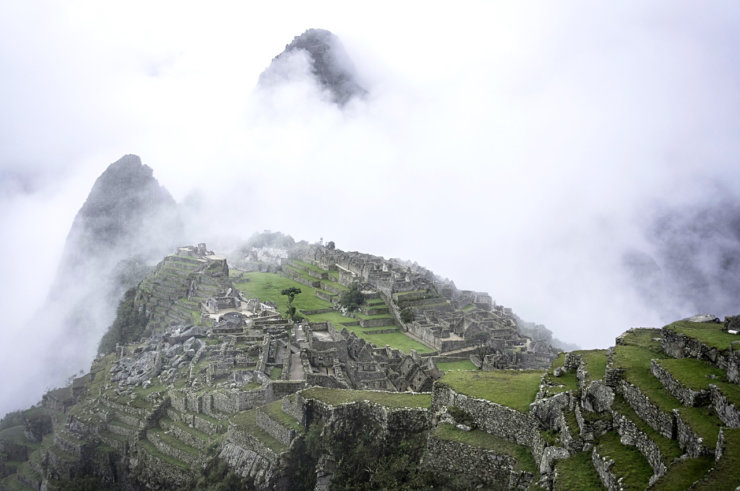
Accommodation at Machu Picchu – the Best Hotels
You can’t sleep at Machu Picchu as it’s a protected site, but you can stay in Aguas Calientes, the nearest village, or simply in Cusco if you’re making the round trip in one day.
Other Frequently Asked Questions About Machu Picchu
Where is the classic photo of Machu Picchu taken from?
From the Guardian’s House (Casa del Vigilante), which is the highest building in Machu Picchu. It’s located at the top of the agricultural terraces, next to the Funerary Rock.
Are there toilets at Machu Picchu?
Yes, right outside. They cost 2 soles.
Are there lockers at Machu Picchu?
There are (paid) lockers at the main entrance where you can leave your belongings. Moreover, any bag (handbag, backpack, etc.) exceeding 40 x 35 x 20 centimeters must be left there.
Is there a restaurant at Machu Picchu?
There’s a snack bar where you can sit, just before the entrance to the site. It offers sandwiches, brownies, etc. Of course, it’s much more expensive than elsewhere. Open from 7 am to 4 pm.
Can I re-enter if I exit?
No, once you leave Machu Picchu, you cannot re-enter a second time.
Is Machu Picchu closed in February?
No, Machu Picchu is never closed.
What closes in February is only the Inca Trail.
What is the altitude of Machu Picchu?
The Machu Picchu sits at an elevation of 2430m above sea level.
For comparison, Cusco is at 3400m.
Will I feel altitude sickness at Machu Picchu?
Symptoms of altitude sickness (mainly headaches and nausea) generally start to be felt around 2500m.
Since Machu Picchu isn’t too high (2430m) and if you have already spent a few days in Cusco and the Sacred Valley (which I highly recommend!), your body should have acclimated and you shouldn’t feel the effects of altitude too strongly.
However, it’s perfectly normal to experience shortness of breath at high altitudes, and there are lots of stairs at the Machu Picchu site, so don’t rush and make sure to stay hydrated.
- If you’re planning on hiking Wayna Picchu (2700m) or Machu Picchu Mountain (3082m), which are higher, you will need to be even more cautious.
To learn more, check out my article: how to avoid mountain sickness
How to Get the Machu Picchu Stamp on Your Passport?
It’s very simple.
Just after the entrance, there is a small table to the left with stamps. You apply it yourself in the passport. It’s free!
In practice, I’ve never heard of anyone being denied entry to a country because of such a stamp, but the risk exists. It’s up to you to decide.
When to Visit Machu Picchu? (Weather)
The best time to visit Machu Picchu is during the shoulder seasons: from April to June and September to November.
Typically, mornings are cloudy but it tends to clear up, so be patient for the photo!
The climate is very changeable in the region and difficult to predict.
- The rainy season extends from December to April, but it rarely rains for several days in a row.
- It’s better to avoid January and February which have the heaviest rainfall.
- The upside of the rainy season is that everything is very green, and there are far fewer tourists. However, it’s not ideal for taking photos or trekking.
- The dry season lasts from May to September. This is also peak season, with June, July, and August being the busiest months.
- Sunday is the busiest day since residents of Cusco can visit Machu Picchu for free.
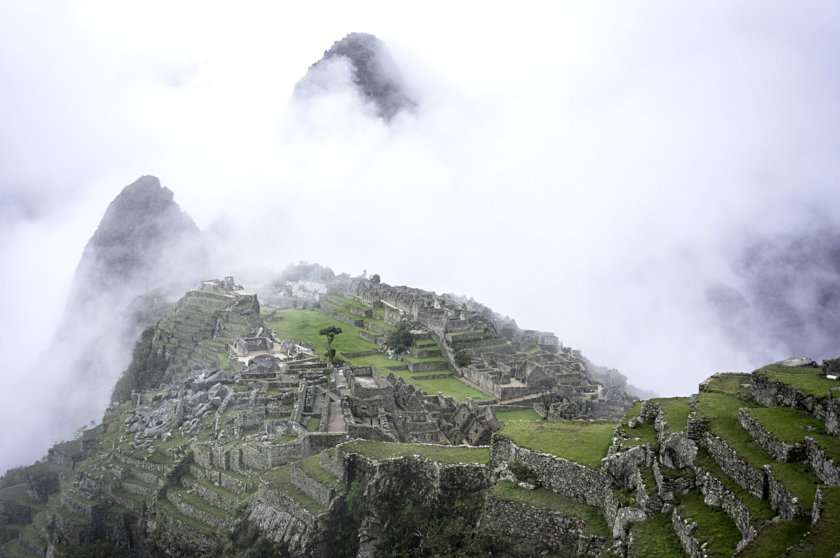
The History of Machu Picchu
This grand symbol of Inca culture still harbors many unresolved mysteries.
But what is known is that the citadel likely served as a residence for the emperor Pachacutec (1438-1471) and was of great importance to the Inca empire due to its strategic geographical location, serving both a religious and administrative function.
Moreover, Machu Picchu owes its preservation to the fact that it was never discovered by the Spanish conquistadors!
The (re)discovery of Machu Picchu is attributed to American explorer and professor Hiram Bingham.
The term “discovery” isn’t really appropriate; it’s better to say that he revealed its existence to the international community by publishing an article in the 1913 National Geographic.
Even though the site had been abandoned by the Incas several centuries earlier and was uninhabited, it was known to local peasants.
It’s also known that several foreigners (including adventurers and gold seekers) had been there before Hiram Bingham but simply had no interest in studying the site or revealing it publicly.
What to See at Machu Picchu?
There’s a plethora to see at Machu Picchu. Here are the main attractions you shouldn’t miss at the site, in addition to the llamas:
- Agricultural Zone: there are many agricultural terraces on Machu Picchu. Corn and potatoes were cultivated here. Even today, it’s a technique still used by the locals.
- Urban Zone: this area contains several buildings and a main square separating the “sacred” sector from the “administrative” sector. You’ll notice that to protect the citadel from rain erosion, there is a drainage system between the urban and agricultural areas for water management.
- Sacred Sector: while we still know little about Machu Picchu, its sacred purpose is undeniable as it houses numerous temples and royal palaces. Recall that the Inca emperor was considered the son of the sun, and Machu Picchu is an ideal spot to dominate the region, both strategically and symbolically.
- Water Temple: as with many pre-Columbian civilizations, water was considered sacred by the Incas, as agriculture was the foundation of their economy. This temple was a place of water worship.
- Temple of the Sun: the Sun God was the supreme deity for the Incas, and the most impressive temples, such as the Coricancha in Cusco, were dedicated to him. You can admire their engineering prowess with well-polished and perfectly interlocking stones, without the use of cement. At the center, there is a half-moon-shaped rock used for religious ceremonies.
- Inca’s Tomb: located beneath the Temple of the Sun, inside a natural cave, it’s highly likely the deceased was a noble. The interior features a rock carved into the shape of stairs with an altar.
- Ñusta’s Residence: this is a two-story building located in the Temple of the Sun complex. The prevailing hypothesis is that it served as lodging for a high-ranking priestess, who was held in high regard by the Inca family. Given its proximity to the Temple of the Sun, it’s clear the building was of great importance.
- Royal Palace: this is a large building with a central patio and several rooms situated below the Temple of the Sun. It’s thus logical to assume they had a strong connection with the sun and were part of the royal family. The emperor likely stayed here when visiting Machu Picchu.
- Sacred Plaza: it’s sacred because it houses two large temples: the Central Temple and the Temple of the Three Windows. At the center of the plaza, there is a rock-shaped altar, likely for llama sacrifices, which were common during Inca times as human sacrifices were rare among the Incas.
- Central Temple: it has small niches that probably held sacred objects (likely made of gold). At the center of the temple, there’s a rectangular-shaped rock where ceremonial objects were placed.
- Temple of the Three Windows: several theories have been proposed for the symbolism of the three windows. One suggests they’re related to the inception of the Inca people because, according to legend, four brothers emerged from three windows. However, based on Machu Picchu’s architectural style, we know it wasn’t built at the beginning of the empire.
- Mortar Palace: its name is derived from the two carved mortars found in one of the rooms. It’s believed they were used to dye fabrics that were then dried on the protruding stones from the walls.
- Intihuatana: more than a sundial, it’s a true solar calendar used by the Incas to determine seasons and predict temperature.
- Funerary Rock: this is a carved stone with a part that sticks out and a small hole, likely used for positioning a mummified body so that it stood upright. There are also stair-like features, probably utilized by the priest during the funeral ceremony.
- Guardhouse: a must-see! It’s the spot where the iconic photo of Machu Picchu is taken from.
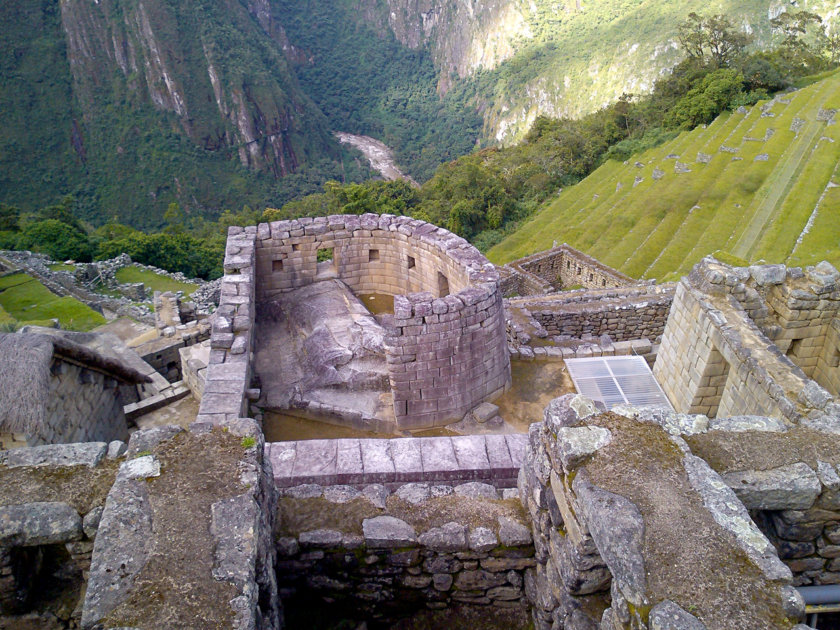
Around the Site
- Inti Punku or Sun Gate: this spot marks the end of the trek on the Inca Trail. It is also accessible from the site without embarking on the trek. The Sun Gate offers a magnificent view of Machu Picchu and the valley!
- Moon Temple: this is an Inca temple accessible via the same path as Wayna Picchu.
- Wayna Picchu: this is the mountain visible in the classic Machu Picchu photo. It’s a favorite among travelers because climbing it is an experience in itself. To gain access, you need to purchase your ticket in advance.
- Machu Picchu Mountain: not to be confused with the actual site of Machu Picchu. This is the other mountain facing Wayna Picchu that offers a panoramic view of the site and its surroundings. It’s taller than Wayna Picchu, with a longer but less physically demanding climb.
What to Bring to Machu Picchu?
Don’t overpack—it’s unnecessary. Carry a small daypack and you can easily leave your larger bag (or suitcase) at your hotel in Cusco or Aguas Calientes, depending on where you spent the night.
Here’s what to bring for your visit to Machu Picchu:
- Your passport and tickets (very important!)
- Water bottle
- Sunscreen
- Hat or cap
- Sunglasses
- A T-shirt and a warm sweater (to put on and take off as needed)
- Comfortable, good quality hiking shoes
- Wool or polyester socks
- Rain poncho or waterproof clothing (it will come in handy! Especially from November to March)
What Not to Do or Bring to Machu Picchu (Prohibitions)
According to Article 19 of the ministerial resolution No. 070-2017-MC, here’s a list of the restrictions at Machu Picchu:
Prohibited Items at Machu Picchu
- Use of tripods, supports or extensions for cameras/mobile phones, or any similar items such as “selfie sticks” (unless with special authorization from the National Culture Commission)
- Backpacks/bags larger than 40x35x20 cm (otherwise, they must be stored in lockers available at the entrance of the Inca citadel)
- Food (though small snacks seem to be tolerated)
- Illegal substances or alcohol (or being under the influence)
- Umbrellas or parasols
- Animals, except for guide dogs and only in essential cases
- Paint or spray cans
- Musical instruments, megaphones, loudspeakers
- High heels or shoes with rigid soles (only soft soles, comfortable sports or hiking shoes are allowed)
- Strollers (baby carriers are allowed, but only without metal)
- Sharp objects, cutting tools, or weapons of any kind
- Banners, posters, flags, streamers, etc. (only guides with more than 5 travelers are permitted to use them, pending subsequent format approval)
- Clothing intended for advertising or promotional purposes
- Walking sticks with hard or metal tips (sticks with rubber tips will be allowed for elderly visitors or those with obvious physical disabilities)
Other Prohibitions at Machu Picchu
- Use of smartphone apps or electronic devices is prohibited in narrow spaces, trails, congested areas at Machu Picchu. They may be used in spacious areas and at points of explanation.
- Jumping, hopping, running, creating disorder or confusion is not allowed
- Climbing on or leaning against walls or structures, touching, moving, or removing elements (lithic or cultural), extracting, harvesting, or disturbing the native flora or fauna is prohibited.
- Carrying out activities that distort the sacred nature of Machu Picchu (such as dancing, fashion shows, ceremonies, etc.) is banned
- Obscene acts, contrary to morality or good manners are forbidden (being naked, disguising, lying down)
- Making any loud or disturbing noise like clapping, yelling, whistling, singing, or anything that might disturb the peace or sacred nature of the Inca city of Machu Picchu is banned.
- It is forbidden to smoke or vape (e-cigarettes), light fires, or litter.
- Straying from established paths and routes is forbidden
- Feeding the animals is prohibited
- Paragliding flights are banned, as are drones or any other similar device for filming or photographing the site for advertising purposes or in high-risk areas.
Book Your Flight at the Best Price
Planning a trip to Peru? To get the best deal on your flights, I recommend using this flight comparison tool, in partnership with Skyscanner.
It’s the easiest way to find the lowest prices for both international flights and domestic flights within Peru—ensuring you pay the best rate with no hassle!
Rent a Car in Peru
Renting a car is one of the best ways to explore Peru at your own pace and make the most of your trip!
Personally, I always use Booking.com Cars for a few key reasons:
- Easily compare prices from all major rental agencies in one place—finding the best deal has never been easier!
- Free cancellation on most bookings, so you can reserve with peace of mind.
- Better insurance coverage at a lower price than rental companies—saving you money with no extra effort.
Click the button below to find the best car rental deals in Peru:
Rent a car
Book entrance tickets and guided visits
Take a travel insurance
Book a tour
✈️ Book your flight
Traveling to Peru? These articles will help you!
Discover all my articles about Mexico: All my articles to help you plan your trip to Mexico are listed there.
You’re using Pinterest? Here is the picture to pin!
